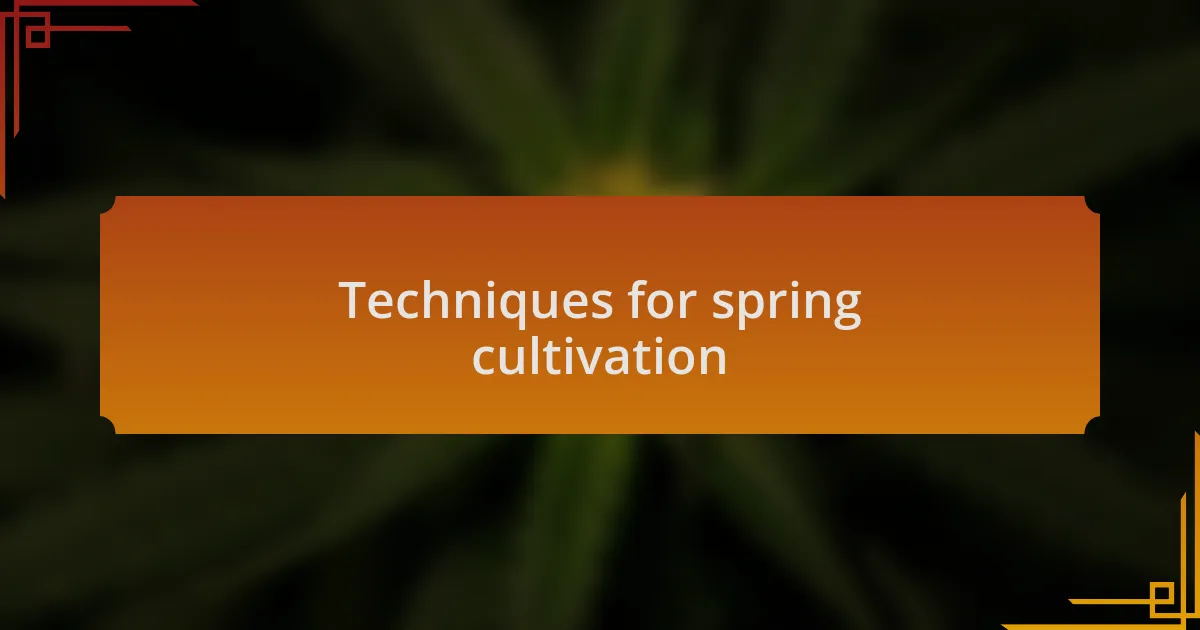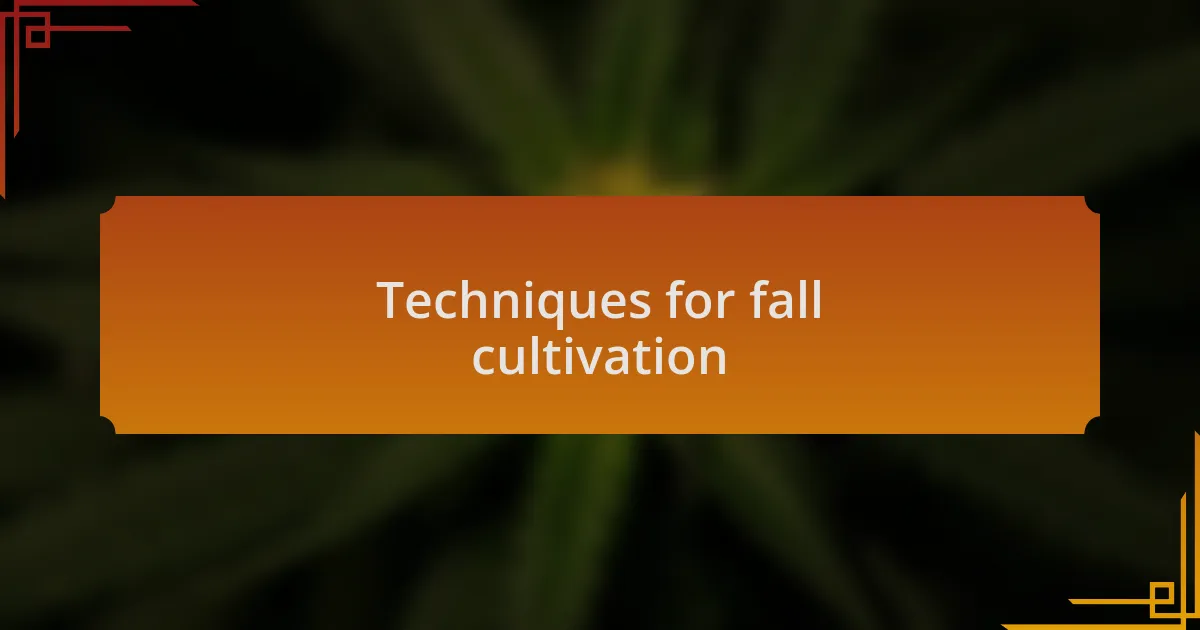Key takeaways:
- Implementing techniques like low-stress training and hydroponics can enhance cannabis yield and quality significantly.
- Adapting cultivation methods according to seasonal changes is crucial for plant health and maximizing growth potential.
- Soil health, nutrient management, and pest control are essential focusing points during the spring, summer, fall, and winter cultivation cycles.
- Continuous experimentation and adjustments to techniques foster a deeper connection between the grower and their plants.

Cannabis cultivation techniques overview
When it comes to cultivating cannabis, various techniques can significantly impact the yield and quality of your harvest. For instance, I’ve found that implementing low-stress training (LST) has allowed me to maximize light exposure and plant growth without causing undue stress. This method not only boosts my harvest but also gives me a hands-on approach to shaping my plants.
I remember a season when I decided to experiment with hydroponics, and I was blown away by the results. The rapid growth I witnessed felt almost surreal—roots thriving in nutrient-rich water instead of soil! This technique demonstrates how important it is to adapt your methods. Have you considered how factors like climate and available space can influence your choice of cultivation methods?
Another technique I’ve delved into is the use of cover crops. These not only help prevent soil erosion but also improve soil health. I recall a time when I introduced clover to my garden, and I was amazed at how it enriched the soil, leading to healthier cannabis plants. It got me thinking: why wouldn’t every grower incorporate this simple strategy for better yields?

Understanding seasonal changes
Understanding how seasonal changes affect cannabis cultivation is crucial for optimizing your plants’ growth. I’ve observed that as the seasons shift, they bring varying temperatures, humidity levels, and light durations which directly influence my plants’ development. For example, I recall a particularly hot summer when I had to adjust my watering schedule to accommodate the increased evaporation rates. Have you experienced the frustration of trying to keep your plants hydrated during those scorching months?
During the fall, the cooler temperatures and reduced sunlight prompted me to transition my lighting techniques. I found myself using spectrum manipulation to enhance flowering, which really made a difference in my yield. I’ll never forget the feeling of anticipation as I watched my plants respond positively to these changes—it’s like having a conversation with them, tuning into their needs.
Winter can be especially challenging but also offers opportunities for reflection and planning. I’ve often used this time to experiment with indoor growing techniques, focusing on seedling production to ensure I’m prepared for the next outdoor season. Are you taking advantage of seasonal downtime to strategize and refine your approaches? Embracing the uniqueness of each season has truly transformed my cultivation experience, making each harvest feel like a well-earned reward.

Importance of adapting techniques
Adapting techniques throughout the growing season is not just a method; it’s an essential part of cultivating healthy cannabis plants. I remember one year when I failed to adjust my nutrient regimen for the spring flush—my plants suffered for it. That experience taught me that being in tune with seasonal changes can significantly enhance plant vitality and overall yield. Do you think your plants could benefit from a customized feeding schedule?
Flexibility in cultivating practices can also open the door to innovation. Last year, I experimented with different pruning techniques during the summer, adjusting my approach based on plant responses. For instance, the way my plants thrived with strategic defoliation was eye-opening. Have you ever tried changing your training methods based on the season? The results can be a mix of delightful surprises and educational moments.
Moreover, adapting techniques helps me stay engaged with my plants and the cultivation process. When I switch things up, I feel a renewed sense of connection to my garden. It’s more than just following a formula; it’s about developing a responsive relationship with your environment. How has adapting your own techniques changed your experience as a grower? Embracing this continuous learning journey not only improves my harvests but also deepens my appreciation for the entire growing cycle.

Techniques for spring cultivation
When spring rolls around, I often shift my focus to soil health. One memorable season, I invested time in creating a compost tea to boost microbial life in my soil. The results were astounding! My plants were healthier, growing more vigorously than I’d ever seen. Have you explored soil amendments that align with spring’s nurturing energy?
During this period, I also pay closer attention to light exposure. As the days grow longer, I find it’s the perfect time to reposition my plants for optimal sunlight. I remember the first year I adjusted their placement; it was like switching on a light bulb for them. Have you noticed how your plants respond to changes in their environment?
Lastly, I tend to employ light pruning and training techniques in spring. I recall the joy of gently training my branches last year, allowing them to stretch toward the sun. This encourages lateral growth and maximizes bud site potential. Have you given thought to how pruning in spring could impact your yield?

Techniques for summer cultivation
When summer arrives, I focus on managing temperatures and humidity levels. I vividly remember one sweltering July, when I installed shade cloths to reduce heat stress on my plants. The difference was remarkable; they thrived in the cooler microclimate I created. Have you considered how simple adjustments can enhance your summer yields?
I also increase my watering frequency during the hotter months. In one particularly dry summer, I realized my plants were constantly thirsty, reaching for moisture. After I set up a drip irrigation system, I was amazed by how quickly they perked up and produced lush, vibrant buds. Have you found effective ways to keep your plants hydrated in the heat?
Pests can be more rampant during summer, so I ramp up my vigilance. I recall one year when I neglected regular checks and paid the price with an aphid infestation. Now, I make it a habit to inspect my plants closely and introduce beneficial insects like ladybugs. It’s a game-changer—how proactive are you in safeguarding your plants?

Techniques for fall cultivation
When fall approaches, I turn my attention to adjusting my feeding regimen, focusing on the nutrients that support blooming. I remember a crisp October day when I switched to a phosphorus-heavy fertilizer, and it felt like magic. Watching my plants respond with vibrant, dense buds was incredibly satisfying—have you experimented with nutrient profiles as the seasons change?
As the temperatures drop, I’ve also learned the importance of monitoring for frost. One chilly morning, I discovered my plants had been nipped, prompting me to invest in protective covers. The relief I felt seeing them thrive afterward was immense; how do you protect your plants from unexpected weather shifts?
I can’t stress enough the significance of pest control in the fall. Having missed a few late-summer inspections in the past, I faced a spider mite invasion as the weather cooled. Now, I stay committed to weekly checks and companion planting—my plants flourish, and I find a sense of peace knowing I’m ahead of potential problems. What strategies do you implement to ensure a healthy harvest as the season changes?

My personal adaptation strategies
As winter settles in, my approach shifts dramatically. I find myself adjusting the light cycles to mimic the natural changes outside. One year, I recall feeling an overwhelming sense of accomplishment when I introduced supplemental lighting, allowing my indoor plants to flourish despite the shorter days. Have you ever had to modify your light settings to keep your plants healthy?
When spring arrives, my focus turns to rejuvenating my soil and preparing for new growth. I vividly remember the excitement I felt while incorporating compost from my own kitchen scraps. It turned a rather mundane task into something rewarding, fueling my plants with rich nutrients. What methods do you use to refresh your soil as the seasons change?
Summer brings a new set of challenges, especially with humidity and heat. I found myself adjusting my watering techniques, switching to deeper but less frequent watering. The first time I noticed the difference—my plants standing tall and vibrant instead of drooping—was a revelation. How do you navigate the challenges of summer cultivation?